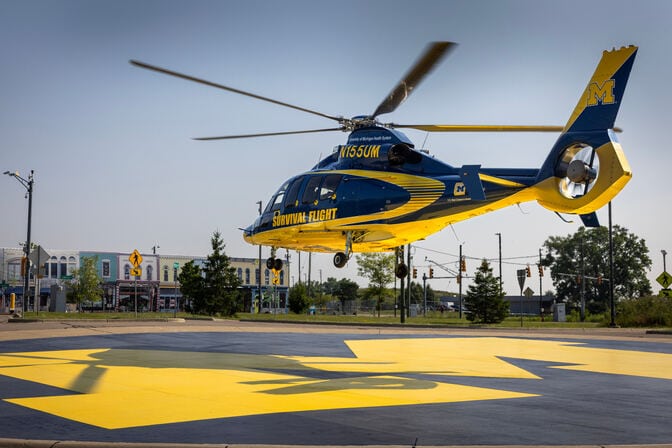
New air mobility corridor to advance eVTOLs and beyond-line-of-sight UAVs
The newly designated airspace links U-M’s autonomy testbed with Detroit’s innovation district.

The newly designated airspace links U-M’s autonomy testbed with Detroit’s innovation district.
Experts
A flight corridor for testing drones and electric aircraft will link the University of Michigan’s one-of-a-kind autonomy research and proving ground facilities in Ann Arbor to Michigan Central’s real-world, urban testbed and innovation district in Detroit.
Announced today by Gov. Gretchen Whitmer, the roughly 40-mile research skyway will be the centerpiece of M-Air, a new public-private partnership U-M is launching for advanced air mobility. M-Air is to be part of the existing public-private partnership Mcity, which provides a connected and automated vehicle test facility under the U-M Transportation Research Institute.
The state of Michigan is providing $1 million in anchor support for M-Air as part of a broader advanced air mobility initiative.
“The next frontier of mobility is moving from land to sky, where drones and electric aerial vehicles can transform how we move people and goods. Michigan Engineering’s M-Air partnership will play an important role in propelling the state to national leadership in advanced aviation technology and developing the workforce we need to sustain it,” said Karen Thole, the Robert J. Vlasic Dean of Engineering and a professor of mechanical engineering and aerospace engineering.
A newly designated airspace is being developed in South East Michigan to advance drones and electric air travel. It is a key feature of M-Air, a new initiative at the University of Michigan. M-Air is an expansion of U-M’s autonomous vehicle testbed, Mcity, focusing on advanced air mobility. M-Air will provide space and support for researchers and companies testing these aircrafts in a real-world environment focusing on beyond-line-of-sight drone operation as well as vertical takeoff and landing for battery-powered aircraft. A White House executive order calling for the development of these capabilities helped accelerate M-Air. M-Air will drive research to improve drone capabilities for helping disaster relief, medical response and more; and improve how autonomous electric aircraft coexist with ground based robotics and crewed aircraft.
M-Air will enable advanced air mobility researchers and companies to test their technologies in realistic environments, with a particular focus on beyond-line-of-sight operation of autonomous aircraft as well as battery powered aircraft that use vertical take off and landing (VTOLs), like helicopters. Current regulations restrict most drones to within the range a pilot can see unaided, which limits their usefulness. Both drones and electric VTOLs have been identified as national priorities in a recent White House executive order.
“It is an exciting time in aerospace with the confluence of electric powertrain, distributed-propulsion-enabled new aircraft designs and autonomous operation. There is an enormous cross-over of talent and technology between electric and automated vehicles and electric aircraft and drones,” said Venkat Viswanathan, director of M-Air and an associate professor of aerospace engineering.
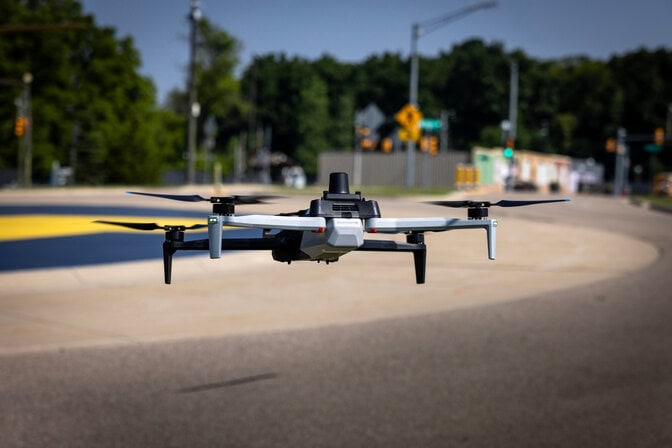
“Drones are already used in agriculture, insurance and infrastructure management, and as the tech stack matures, drones have the potential to be the cheapest, fastest way of transporting goods. M-Air will help solve technical problems and help answer regulatory questions that will enable advanced aircraft to fulfill their potential.”
The effort is funded through the Michigan Economic Development Corporation (MEDC), with infrastructure support from the Michigan Department of Transportation (MDOT). It will be an expansion to the Mcity test facility, which provides physical, remote, mixed-reality and fully simulated environments for testing connected and automated vehicles. In addition to building and managing ground testing facilities, Mcity will manage user access for the flight corridor in partnership with MDOT and Michigan Central.
“MDOT continues to deliver on its mission to connect people and serve communities across all modes of transportation, and we are particularly excited to explore the safe integration of this novel aviation technology as one more mobility option for the citizens of Michigan,” said Bryan Budds, director of the MDOT Office of Aeronautics. “Additionally, we look forward to working with the University of Michigan and communities along the corridor to ensure the thoughtful deployment of this technology in the region.”
M-Air’s new “iron bird” testbed facilities will enable users to demonstrate the flight performance of new batteries and motors on the ground before trial runs in the air. The flight corridor will be outfitted with a drone traffic management system that meets national safety standards, enabling drones to share low-altitude airspace even beyond the operator’s line of sight. It will also support swarm operations testing, with multiple drones working together on a shared objective.
The corridor will run through U-M Dearborn, providing access to the state-of-the-art facility to faculty and students at a second U-M campus.
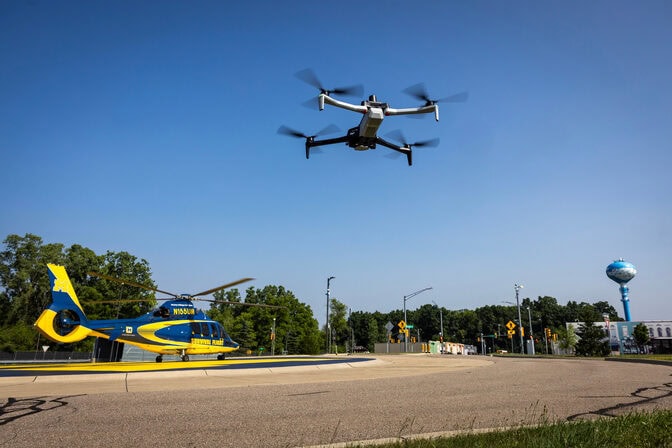
At its other end point, Michigan Central is a business incubator focused on advanced mobility, supporting start-ups and small businesses that may benefit from easy access to flight testing. It’s also home to the Advanced Aerial Innovation Region, which focuses on commercial drone development.
“M-Air is Michigan’s launchpad for the next wave of autonomous flight,” said Ben Marchionna, chief innovation ecosystem officer at the MEDC. “It gives researchers and founders a real-world airspace testbed to safely deploy, learn fast and get hardware ready to power Michigan’s next generation of innovative industries. That’s the ‘Make It in Michigan’ promise: invent it, build it and grow it—without leaving the state.”
One way that U-M intends to use M-Air is to help advance Michigan Medicine’s Survival Flight service, which transports patients and carries organs for transplant. Already, helicopters could benefit from drone detection systems to prevent collisions in case drones stray into the wrong airspace. And in the future, Survival Flight may use electric aircraft or smaller, lighter drones to transport organs and medicines.
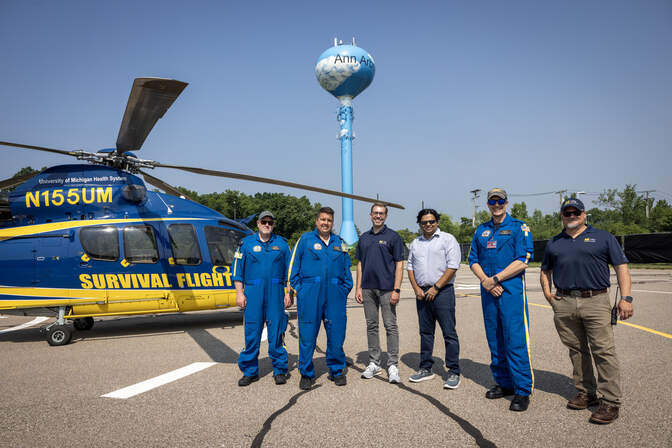
“As an air medical team, Survival Flight is proud to support the launch of M-Air, which strengthens Michigan’s leadership in advanced mobility and supports a future where every second saved has the power to save a life. By enabling real-world testing of beyond-line-of-sight and VTOL capabilities, M-Air will help ensure drones are safely and effectively integrated into critical response operations,” said Donna Robinson, director of Survival Flight.
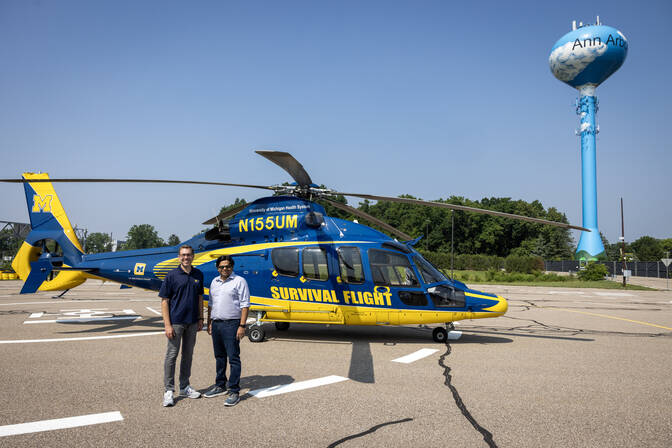
Among its educational initiatives, M-Air will participate in the Perot Jain TechLab series, which enables students to collaborate with entrepreneurs. That’s just one of the ways it will help incubate, attract and nurture aerospace startups and improve student experiential learning from K-12 to graduate education.
M-Air is currently finalizing its founding industry members. Members of M-Air will help guide the initial research directions as well as the construction of the testing facilities and corridor, identifying use cases and collaborating on grant proposals.
In addition to the $1 million from MEDC’s Office of Future Mobility and Electrification, U-M will contribute $1 million.
Previously, the M-Air name belonged to a netted outdoor drone testing space near the aerospace engineering and robotics departments. That facility will now be called M-Air Net.